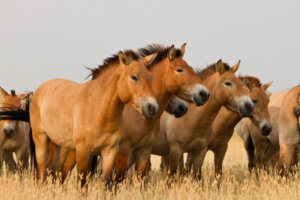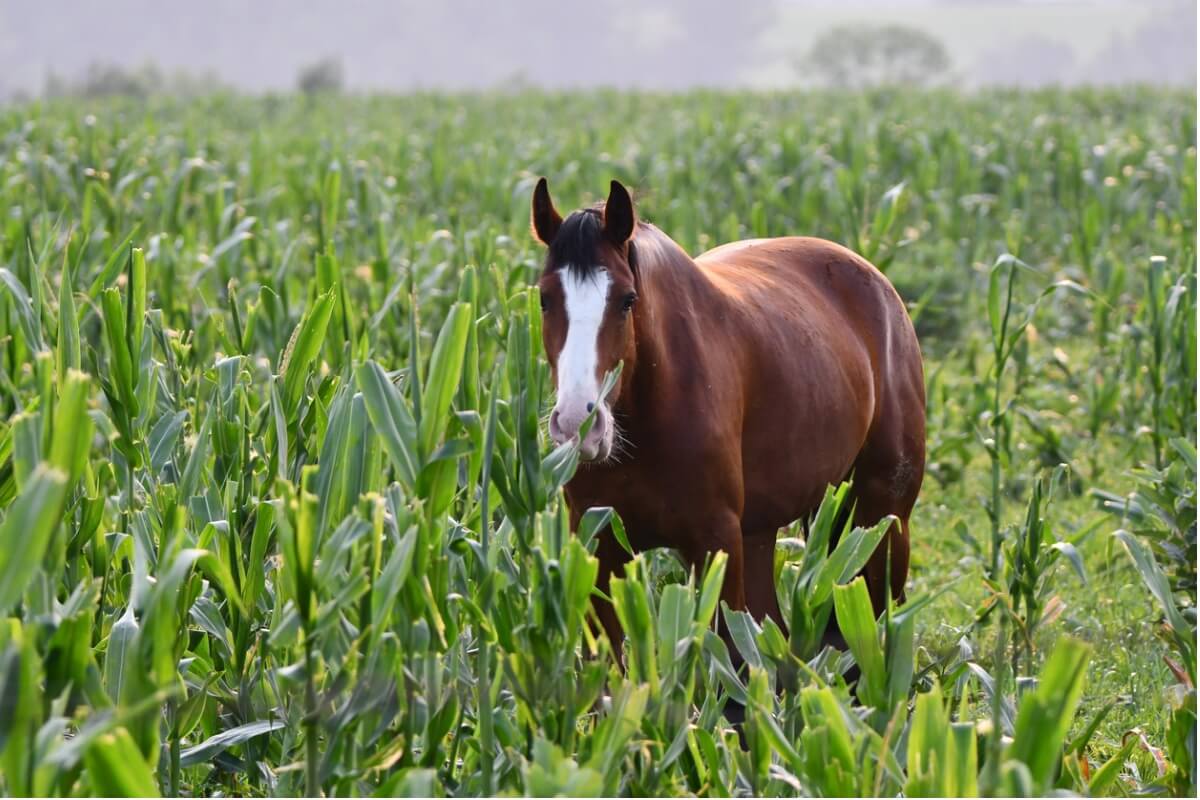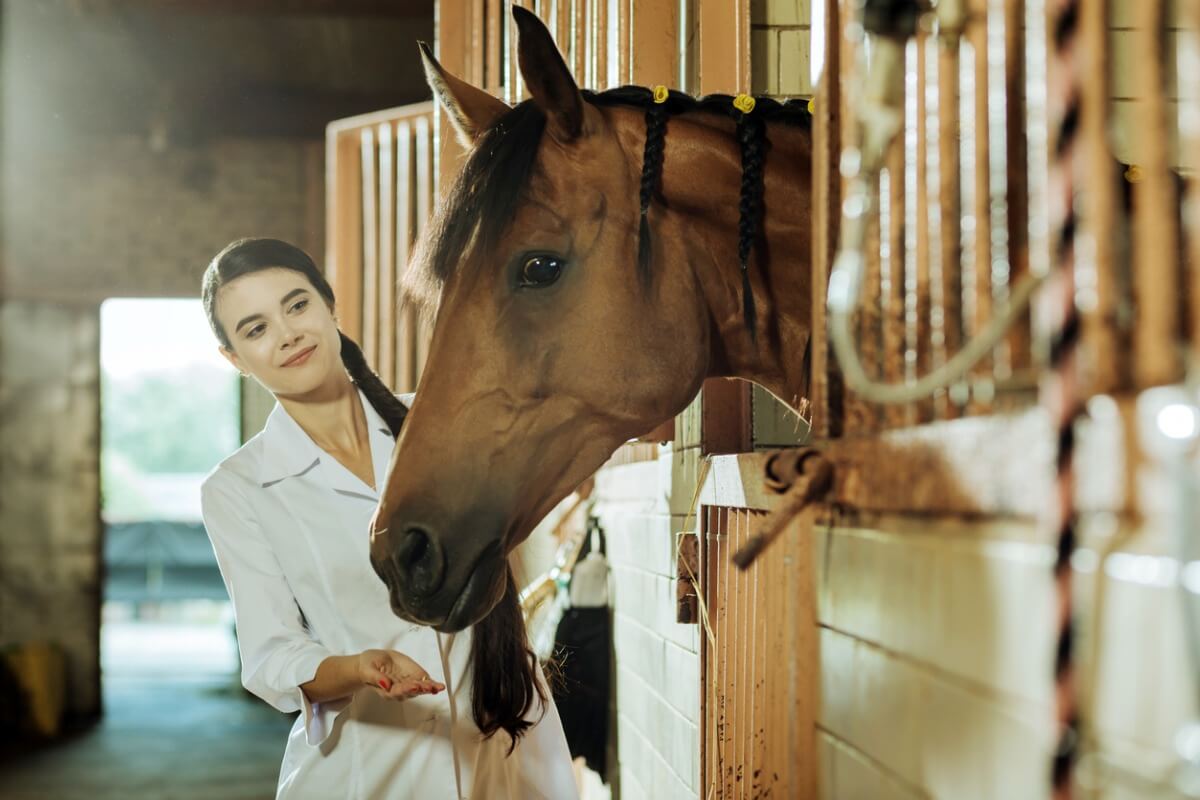What Is Equine Clinical Ethology?

The study of animal behavior isn’t only restricted to dogs and cats. In fact, any non-human living in confined conditions is susceptible to developing psychological disorders or behavioral problems. This is precisely the subject of equine clinical ethology which looks at behavioral disorders that horses may suffer from.
This area is the union between ethology and veterinary science, and is the best way to take care of horse mental health. Let’s have a look at it in detail.
Fundamentals of equine clinical ethology
If ethology is the science that studies the different aspects of animal behavior, adding the veterinary branch makes it possible to diagnose and treat behavioral and mood problems in horses (in this case). For this purpose, the animal’s normal and healthy behavior is also studied.
With mental disorders in a horse, going to the veterinarian or an equine trainer alone isn’t entirely effective. To solve the problem, a complete and global vision of the horse’s psychological needs is necessary.

How is a behavioral problem diagnosed in a horse?
Based on the knowledge of the horse’s normal and healthy behavior, several deviations can be detected through direct observation. This is usually detected by the owner, and is confirmed by the examination of the equine ethologist.
In addition, the horse’s owner, or trainer, is interviewed. It’s important to make a good anamnesis, as it’s necessary to know the frequency and intensity of this behavior, as well as how long the horse has had it.
Finally, it’s also crucial to perform a physical health examination. This will ensure that the problems being observed aren’t a symptom of a physical illness. If they are, treatment should be directed at that ailment and not at the horse’s behavior.
Major behavioral problems in horses
Like any other animal, horses can develop behavioral problems. We’re not referring to horse habits that annoy humans or make training difficult, but rather to those that derive from psychological distress, such as fear or boredom.
Therefore, a disobedient horse can’t be said to have behavioral problems. If it bites when someone’s going to ride it, then this is simply the horse not wanting to have humans ride it. However, if it bites when there’s nothing threatening around, then it’s a behavioral problem. That said, let’s look at the most common ones:
- Aggressiveness: This behavior usually stems from fear. If they’re subjected to situations in which they feel cornered or trapped on a daily basis, then they’ll develop aggression as a habitual defensive pattern.
- Eating disorders: These problems usually stem from improper feeding by the caregiver. For example, a horse that only has access to food in very restricted periods of time will be more prone to anxious eating.
- Stereotypies: Repetitive behaviors without a survival-related purpose, such as continuous rocking, chewing on the wood in the stall, or swallowing air.
- Pathological fears: These usually come from deficient training or bad socialization. Thus, the horse acquires a fear of situations, objects, or people that are harmless, to which it responds with fleeing and/or aggressive behavior.
Therapy used in equine clinical ethology
When dealing with a foal, early detection of these behavioral problems greatly facilitates therapy. At this time, behavioral redirection through familiarization with the environment and socialization is often used. Procedures such as receiving medications, getting in and out of trailers, the application of bandages, etc. will be practiced.
Foals, as they’re developing, have a greater facility to correct their behavior and recondition themselves to the environment.
Therapy in equine clinical ethology is based on 4 fundamental pillars. Let’s take a look at them:
- Environmental enrichment: This is essential in order to avoid boredom and the problems derived from it. It consists of changing or contributing elements to the environment.
- Psychotherapy: Behavior modification techniques, such as habituation or counterconditioning.
- Psychopharmaceuticals: These are sometimes used as supportive treatment in very severe cases. Examples are antidepressants, hormonal treatments, and anxiolytics.
- Surgery: Castration is the most common. Some horses temper their behavior in this way, allowing their human and the therapist to handle them safely.

A horse living free or in decent conditions doesn’t usually develop behavioral problems. Therefore, part of the animal’s therapy will be to improve the aspects of its care and life that are causing suffering. It’s useless to carry out therapy if they then return to a stable for several hours on end. You should always focus on their welfare.
The study of animal behavior isn’t only restricted to dogs and cats. In fact, any non-human living in confined conditions is susceptible to developing psychological disorders or behavioral problems. This is precisely the subject of equine clinical ethology which looks at behavioral disorders that horses may suffer from.
This area is the union between ethology and veterinary science, and is the best way to take care of horse mental health. Let’s have a look at it in detail.
Fundamentals of equine clinical ethology
If ethology is the science that studies the different aspects of animal behavior, adding the veterinary branch makes it possible to diagnose and treat behavioral and mood problems in horses (in this case). For this purpose, the animal’s normal and healthy behavior is also studied.
With mental disorders in a horse, going to the veterinarian or an equine trainer alone isn’t entirely effective. To solve the problem, a complete and global vision of the horse’s psychological needs is necessary.

How is a behavioral problem diagnosed in a horse?
Based on the knowledge of the horse’s normal and healthy behavior, several deviations can be detected through direct observation. This is usually detected by the owner, and is confirmed by the examination of the equine ethologist.
In addition, the horse’s owner, or trainer, is interviewed. It’s important to make a good anamnesis, as it’s necessary to know the frequency and intensity of this behavior, as well as how long the horse has had it.
Finally, it’s also crucial to perform a physical health examination. This will ensure that the problems being observed aren’t a symptom of a physical illness. If they are, treatment should be directed at that ailment and not at the horse’s behavior.
Major behavioral problems in horses
Like any other animal, horses can develop behavioral problems. We’re not referring to horse habits that annoy humans or make training difficult, but rather to those that derive from psychological distress, such as fear or boredom.
Therefore, a disobedient horse can’t be said to have behavioral problems. If it bites when someone’s going to ride it, then this is simply the horse not wanting to have humans ride it. However, if it bites when there’s nothing threatening around, then it’s a behavioral problem. That said, let’s look at the most common ones:
- Aggressiveness: This behavior usually stems from fear. If they’re subjected to situations in which they feel cornered or trapped on a daily basis, then they’ll develop aggression as a habitual defensive pattern.
- Eating disorders: These problems usually stem from improper feeding by the caregiver. For example, a horse that only has access to food in very restricted periods of time will be more prone to anxious eating.
- Stereotypies: Repetitive behaviors without a survival-related purpose, such as continuous rocking, chewing on the wood in the stall, or swallowing air.
- Pathological fears: These usually come from deficient training or bad socialization. Thus, the horse acquires a fear of situations, objects, or people that are harmless, to which it responds with fleeing and/or aggressive behavior.
Therapy used in equine clinical ethology
When dealing with a foal, early detection of these behavioral problems greatly facilitates therapy. At this time, behavioral redirection through familiarization with the environment and socialization is often used. Procedures such as receiving medications, getting in and out of trailers, the application of bandages, etc. will be practiced.
Foals, as they’re developing, have a greater facility to correct their behavior and recondition themselves to the environment.
Therapy in equine clinical ethology is based on 4 fundamental pillars. Let’s take a look at them:
- Environmental enrichment: This is essential in order to avoid boredom and the problems derived from it. It consists of changing or contributing elements to the environment.
- Psychotherapy: Behavior modification techniques, such as habituation or counterconditioning.
- Psychopharmaceuticals: These are sometimes used as supportive treatment in very severe cases. Examples are antidepressants, hormonal treatments, and anxiolytics.
- Surgery: Castration is the most common. Some horses temper their behavior in this way, allowing their human and the therapist to handle them safely.

A horse living free or in decent conditions doesn’t usually develop behavioral problems. Therefore, part of the animal’s therapy will be to improve the aspects of its care and life that are causing suffering. It’s useless to carry out therapy if they then return to a stable for several hours on end. You should always focus on their welfare.
All cited sources were thoroughly reviewed by our team to ensure their quality, reliability, currency, and validity. The bibliography of this article was considered reliable and of academic or scientific accuracy.
- Luna Blasio, A., & Sanabria Cera, S. Etología y bienestar animal.
- Vallejo, R. G., & Talegón, M. I. El dolor como causa de problemas de comportamiento en caballos.
- Hernández, D. A., & Roa, F. (2019). ADIESTRAMIENTO ETOLÓGICO DEL CABALLO. REVISTA FAGROPEC, 79.
- Quiroga Ayala, M. (2013). Comportamientos anormales en caballos estabulados.
This text is provided for informational purposes only and does not replace consultation with a professional. If in doubt, consult your specialist.








